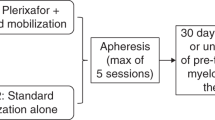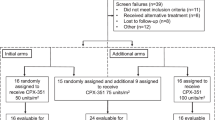Abstract
Seventy women with high-risk stage II (n = 10), IIIA (n = 12), IIIB (n = 11), or IV (n = 37) breast cancer received cyclophosphamide 6000 mg/m2, etoposide 2400 mg/m2, and carboplatin 1200 mg/m2 followed by infusion of autologous hematopoietic stem cells (AHSC). Women with high-risk stage II disease had eight or more involved axillary lymph nodes (n = 9) or axillary and breast relapse following lumpectomy, chemotherapy, and radiation therapy (n = 1). Women with measurable stage III or stage IV disease were required to demonstrate complete or partial response to conventional-dose chemotherapy prior to transplant. The overall (complete plus partial) response rate for the 31 patients not in complete remission at the time of transplant was 55%. With a median follow-up of 545 days, the 2-year actuarial progression-free survival rates for patients with stage II, IIIA, IIIB and IV are 86, 75, 42 and 13%, respectively. Factors independently predictive of longer progression-free survival by multivariate analysis included lower stage disease, status of disease at transplant (in CR vs not in CR), and positive estrogen receptor status. Factors predictive of more rapid neutrophil engraftment by multivariate analysis included post-transplant administration of hematopoietic growth factors, greater number of infused CFU-GM, mobilization with G-CSF or cyclophosphamide/G-CSF (vs mobilization with GM-CSF or no mobilization), and lower stage disease. Only one patient (1.4%) died prior to day 100 from any cause. High-dose cyclophosphamide, etoposide, and carboplatin followed by infusion of AHSC constitutes an active and well-tolerated regimen in the treatment of women with high-risk non-metastatic or metastatic breast cancer.
This is a preview of subscription content, access via your institution
Access options
Subscribe to this journal
Receive 12 print issues and online access
$259.00 per year
only $21.58 per issue
Buy this article
- Purchase on Springer Link
- Instant access to full article PDF
Prices may be subject to local taxes which are calculated during checkout
Similar content being viewed by others
Author information
Authors and Affiliations
Rights and permissions
About this article
Cite this article
Klumpp, T., Goldberg, S., Magdalinski, A. et al. Phase II study of high-dose cyclophosphamide, etoposide, and carboplatin (CEC) followed by autologous hematopoietic stem cell rescue in women with metastatic or high-risk non-metastatic breast cancer: multivariate analysis of factors affecting survival and engraftment. Bone Marrow Transplant 20, 273–281 (1997). https://doi.org/10.1038/sj.bmt.1700882
Received:
Accepted:
Issue Date:
DOI: https://doi.org/10.1038/sj.bmt.1700882



